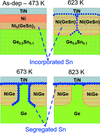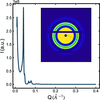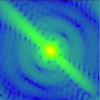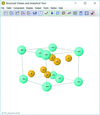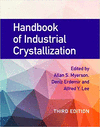issue contents
June 2020 issue

Cover illustration: Some of the novel experimental apparatus that features in this issue. A gradient heater for variable-temperature measurements resolved in space [O'Nolan et al. (2020). J. Appl. Cryst. 53, 662–670], the multipurpose QMAX furnace, which allows full reciprocal-space mapping up to 2000 K under controlled atmosphere at the ESRF [Guinebretiere et al. (2020). J. Appl. Cryst. 53, 650–661], and 3D-printed holders for in meso in situ fixed-target serial X-ray crystallography [Huang et al. (2020). J. Appl. Cryst. 53, 854–859].
research papers
Instrumentation for sub-millisecond time-resolved small-angle neutron scattering measurements at NIST is described and applied to the reorientation dynamics of elongated hematite nanoparticles.
A comprehensive analysis focused on Sn segregation during the Ni/GeSn solid-state reaction was carried out. It was demonstrated that Sn is soluble in the various Ni/GeSn intermetallic phases and that, when the temperature increases, the Sn segregation occurs first at grain boundaries, which can hamper Ni diffusion and delay the intermetallic formation.
Download citation


Download citation


Open  access
access
 access
accessThis study demonstrates a new preparation method for single-crystal X-ray diffraction samples using a focused ion beam. The results of the structure determination and electron density maps with differently prepared samples are discussed, to evaluate this new method.
In this article, the effect of stretching of short X-ray pulses after symmetric or asymmetric diffraction on crystal systems is studied. This is used to determine the optimal experimental arrangement to minimize the pulse stretching during diffraction.
The formation of compressive strain in surface-damaged crystals after polishing or grinding is explained by formation of dislocations which penetrate into the damaged layer of the crystal and have common Burgers vector components parallel to the surface.
Download citation


Download citation


Detailed analysis of the high-flux deficiencies of pixel-array detectors leads to a protocol for the measurement of structure factors of unprecedented accuracy even for inorganic materials, and this significantly advances the prospects for experimental electron-density investigations.
CCDC reference: 1990530
This article presents the capability of the QMAX furnace, devoted to reciprocal space mapping through X-ray scattering at high temperature up to 2000 K.
A new approach to variable-temperature measurements is presented, where the sample temperature changes continuously as a function of position.
A calculation procedure for X-ray total scattering and the pair distribution function from a crystalline structural model is presented. It allows one to easily and precisely deal with diffraction-angle-dependent parameters such as the atomic form factor and the resolution of the optics.
Exact and approximate formulas for equatorial aberration of a continuous-scan Si strip detector are compared.
Open  access
access
 access
accessThis article describes rational strategies for the optimization of crystal growth using precise in situ control of the temperature and chemical composition of the crystallization solution through dialysis, to generate crystals of the specific sizes required for different downstream structure determination approaches.
The SASPDF method, an extension of the atomic pair distribution function (PDF) analysis to the small-angle scattering (SAS) regime, is presented. The method is applied to characterize the structure of nanoparticle assemblies with different levels of structural order.
Open  access
access
 access
accessA fast and exact algorithm to calculate the powder pair distribution function (PDF) for the case of periodic structures is presented. The algorithm especially improves X-ray and electron PDF calculations, and the handling of instrumental resolution functions.
Open  access
access
 access
accessA portable small-angle X-ray scattering instrument with geometrical dimensions suitable for installation at the D22 instrument was designed and constructed for simultaneous small-angle X-ray and neutron scattering experiments at ILL.
The diffraction response of a single crystal to an electric field is measured by X-ray diffraction at angles close to π. Such schemes allow one to determine with high (∼10−5–10−6) accuracy the relative changes in the lattice constant.
This work describes the application of X-ray ptychography for the inspection of complex assemblies of CdSe/CdS octapod nanocrystals embedded in 24 ± 4 µm-thick polymethyl methacrylate and polystyrene matrices.
Open  access
access
 access
accessDifferent studies in X-ray microscopy have arrived at conflicting conclusions about the dose efficiency of near- and far-field imaging approaches. X-ray far-field ptychography is compared with near-field holography and near-field ptychography in computer simulations. All three methods are highly dose efficient, with far-field ptychography offering slightly better low-dose imaging characteristics.
Open  access
access
 access
accessA method for the simultaneous measurement of a wavefront's phase and the projection hologram of an unknown sample is presented. This method relies on an updated form of the speckle tracking approximation, which is based on a second-order expansion of the Fresnsel integral.
The principles of using the Laue analyzer as an X-ray optical element for separating two characteristic lines of an X-ray tube are presented.
Very asymmetric crystal diffraction was obtained from a finely polished silicon crystal set to reflect in Bragg diffraction at grazing incidence for the 333 reflection. The angle of incidence to achieve Bragg diffraction was varied between 1.08 and 0.33° by changing the X-ray energy from 8.100 to 8.200 keV. The effects of surface undulations were identified, and the results are compared with dynamical X-ray diffraction calculations.
Dynamical X-ray diffraction simulations of very asymmetric diffraction from single crystals of silicon were made to accompany an experimental rocking-curve topography study reported in a seperate paper. Effects on rocking curves were found and are reported. The development of Uragami [(1969), J. Phys. Soc. Jpn, 27, 147–154] for Takagi–Taupin simulations was followed and applied to the case of both convex and concave surface undulations.
Rules for the experimental design of scattering contrast in reflectometry experiments of biological surface architectures are derived using an information theoretical framework.
A versatile model of disordered nanoparticles is proposed for the purpose of analysing small-angle scattering data. The approach generalizes the classical clipped Gaussian field models of random structures by allowing the clipping function to be space dependent.
An algorithm based on the matching of q vector pairs is combined with three-dimensional pattern matching using a nearest-neighbors approach to index Laue and monochromatic serial crystallography data recorded on small-unit-cell samples.
short communications
Neutron crystal structure analysis of hen egg-white lysozyme hydrogen/deuterium exchanged before crystallization was performed by a joint X-ray and neutron refinement. Differences in hydrogen/deuterium exchange behavior between this study and previous ones were observed.
PDB reference: hen egg-white lysozyme, 6k8g
computer programs
New developments in the program CrystalCMP are presented, and the program is tested on a large number of crystal structures extracted from the Cambridge Structural Database.
SVAT4 is a computer program for interactive visualization of three-dimensional crystal structures. A wide range of functions are available for structural analysis.
laboratory notes
Open  access
access
 access
accessThe design and assembly of two 3D-printed holders for high-throughput in meso in situ fixed-target crystallographic data collection are described.
new commercial products
Free 

book reviews
Free 

Free 



 journal menu
journal menu










